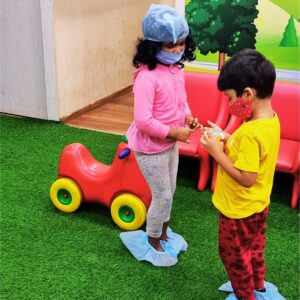Part 2: What Goes On In The Minds of Hypersensitive Kids?

Hypersensitivity isn’t a sign or symptom. It is a behavioral trait, one which the child or adults don’t realize themselves. Highly sensitive children are deeply attuned to what happens in themselves and the spaces around, and often experience things differently to what many of us feel. Today’s fast-paced world is one of constant bombardment, of constant triggering from mobiles and gadgets, flashes of light from billboards and tech, noise and chaos from traffic and other sources. There is rarely a moment of respite, peace and quiet. Compare this to earlier times, where children were allowed to be by themselves, get bored, find hobbies or keep themselves occupied, and in thus doing were able to find ways to manage stimuli, regulate emotions and course correct whenever they were overwhelmed. With all of this chaos and volatility, it is hardly surprising that children are overwhelmed and react.
As parents and guardians, it is important for us to know what goes on in the minds of children. How they react when they’re overwhelmed differs from one to the other. Hypersensitivity manifests differently in different situations. At the pediatric dental clinic, it may mean children creating too much of a fuss or refusing to co-operate with the dentist for simple instructions like ‘open your mouth’. At the school, it may mean them staying by themselves, or unforeseen outbursts when pushed to deliver on an assignment or homework.
What are the traits of hypersensitive kids and how can we interpret them in a way where it can be addressed?
Hypersensitivity in children plays out in two distinct ways. Mental or emotional hypersensitivity where too much stress or pressure on the brain causes children to react strongly. The child becomes overly aware of the surroundings, either disconnects and zones off or goes deep into thought frequently. Physical hypersensitivity where the child reacts strongly to stimuli of any kind – sounds such as sudden loud noises, sights such as too harsh lights, touch which can be either prickly or hard surfaces, smells or scents that linger in a regular clinic such as the smell of disinfectant which often go unnoticed by the rest of us, and even tastes – the metallic taste of medicines or excessive bitterness of a lemon.
While experiencing the world more intensely than others, these children need to be understood deeply. We need to know more about what drives them and why they behave as they do. As parents it is upto us to decipher their thinking and actions, so as to make it easy for them to understand and react with the world and grow up interacting with it easier than from a state of constant conflict.
One thing to note before listing down hypersensitivity traits of children, is that it is not about unruliness or purposeful or even defiance by itself but a reaction of the child to some kind of stimuli which they can’t control.
Behavioral Indicators
Behavioral indicators are the very obvious signs that children display either to parents or even care providers to notice. Some common ones are,
- Dislike towards loud noises, harsh lights, and specific clothing and surface textures
- Easily startled by sudden noise, movements, activity
- Resists changes in daily routine
- Has meltdowns or tantrums, displays unprovoked behavior when becoming overwhelmed by emotions
- Requires frequent downtime or break from stimulating situations
Emotional Indicators
Emotions are extreme and all over the place triggered by heightened sensitivity to stimuli and emotions. Small children have no other ways to articulate or express than this, and it can get overwhelming for them and the parents.
- Experience emotions intensely and immediately
- Picks up on others’ emotions and are highly attuned to others’ feelings
- Easily offended or hurt by questions, criticisms and feedback
- Thoughtful and introspective, zoning off during pressure situations and require time to process their emotions
- Prone to anxiety which cannot be articulated, especially in unpredictable or uncertain situations
Social Indicators
Social indicators of a highly sensitive child often revolve around their interactions with other kids, the parents or immediate family, doctors, dentists or third party people who have to intervene with their health at specific times.
- Feels drained in large spaces, groups and prefers immediate familiar people
- Observes others, gauges other’s moods before interacting
- Takes time to warm up to new people and is selective with their friendships
- Strongly dislikes certain activities or social situations and can do anything to avoid them
- Appears shy or withdrawn or aloof
Over-sensitive or hypersensitive children need to be dealt with differently than others. They need to be prepared when taken for something big such as a visit to the dentist. It is only when they go of their free will or are comfortable with people, is when the tasks become easy.
It is this reason why Small Bites Dental Clinic recognizing the need to tailor services for its little patients, has built a space that is free flowing, fun and themed, so children of different sensitivities do not get overwhelmed and over-react. By building a Sensory Adaptive Dental Experience Center (SADE), the pediatric dentists are able to help children with oral care without being overwhelming or stressful for them.
For Part 1, read here.
In Part 3 of these series, we try to understand what Small Bites has that makes it apt to address the needs of hypersensitive children and the stressors that otherwise can overwhelm them.

